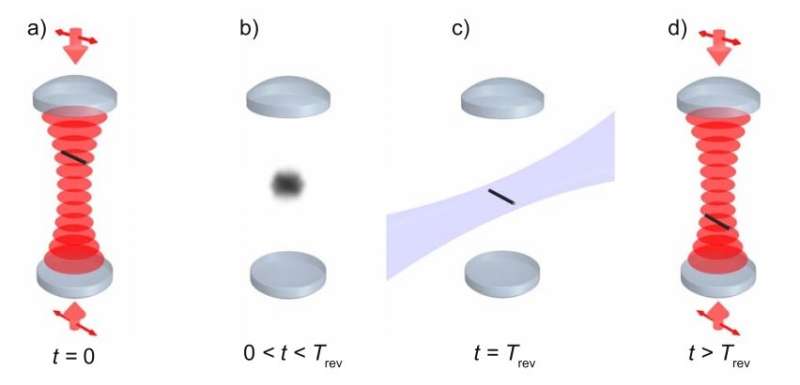December 19, 2018 feature
Proposed test of quantum superposition measures 'quantum revivals'

Physicists have proposed an entirely new way to test the quantum superposition principle—the idea that a quantum object can exist in multiple states at the same time. The new test is based on examining the quantum rotation of a macroscopic object—specifically, a nanoscale rotor, which is considered macroscopic despite its tiny size.
Until now, most tests of quantum superposition have been based on linear, rather than rotational, motion. By examining rotational motion, the new test may lead to applications such as quantum-enhanced torque sensing, and could provide insight into a variety of open questions, such as what causes the quantum wave function to collapse.
The physicists, led by Klaus Hornberger at the University of Duisburg-Essen, Germany, have published a paper on the proposed test in a recent issue of the New Journal of Physics.
Quantum superposition arises because, at the quantum scale, particles behave like waves. Similar to the way in which multiple waves can overlap each other to form a single new wave, quantum particles can exist in multiple overlapping states at the same time. If quantum superposition occurred in everyday life, we might observe phenomena like Schrödinger's cat, which is dead and alive at the same time until it is measured, forcing it to assume a single state.
In the new paper, the researchers propose levitating a nanoscale rotor using optical tweezers, which are formed by two counter-propagating polarized laser beams that cause the rotor to tightly align with the field polarization. When the beams are switched off, however, the tightly oriented rotor is predicted to quickly disperse into a superposition of all possible rotation states as it falls toward the ground due to gravity.

Interestingly, the rotor is predicted to experience "quantum revivals" in which, at regular intervals in time, the collective interference of all of the rotation states leads to the re-emergence of the initial state that it occupied when it was aligned by the laser beams. The orientation can potentially be measured by illuminating the rotor with a weak probe laser, and the trapping laser could be switched back on to catch the rotor in this state before it reaches the ground.
So far, orientational quantum revivals have been observed only in gases of diatomic molecules. As the nanorods consist of at least 10,000 atoms, they are much larger than the diatomic molecules, allowing for quantum mechanics to be tested in an uncharted regime.
The physicists expect that it will be possible to observe quantum revivals of the nanorods using existing technology, such as by using a carbon nanotube as the rotor. If so, the observation would represent a new macroscopic test of quantum superposition.
"By observing the quantum revivals, we hope to confirm quantum mechanics at an unprecedented mass and complexity scale, thereby exploring the quantum-to-classical borderline," Hornberger told Phys.org.
In the future, coauthor James Millen, now at King's College London, plans to perform the proposed experiment to detect macroscopic quantum revivals.
"Testing whether quantum physics breaks down at a high mass is an exciting, yet daunting, challenge," Millen said. "We may have to develop entirely new technologies to isolate nanoscale particles, or even perform experiments in space. However, this experiment which we propose opens up an entirely new route to probing enigmatic quantum effects, in a way which I firmly believe is feasible with today's technology. Furthermore, we will be able to harness this physics to develop useful devices of unprecedented sensitivity."
More information: Benjamin A. Stickler et al. "Probing macroscopic quantum superpositions with nanorotors." New Journal of Physics. DOI: 10.1088/1367-2630/aaece4
Journal information: New Journal of Physics
© 2018 Science X Network





















